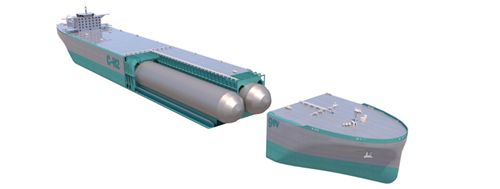News
GEV's Pilot C-H2 ship to be operable by mid-2020s

GEV has commenced the development of a pilot-scale C-H2 Ship with a cargo capacity of 430t of hydrogen. The addition of a 430t capacity hydrogen ship will:
- Align with the scale, timeline, and downstream market opportunities for green hydrogen projects under consideration, both in Asia Pacific and Europe.
- Reduce overall development risk, capital, and construction schedule, and
- Enable GEV to achieve its target of an operating fleet of C-H2 vessels by mid 2020’s
Development program is targeting American Bureau of Shipping (ABS) Approval in Principle (AIP) in Q3 2021 and Full Class Approvals late in 2022.
The 430t ship specification will be a scaled version of the 2,000t C-H2 ship (that received AIP in March 2021) and benefits from the engineering and HAZID studies already completed.
The downstream market application for pilot scale volumes of green hydrogen will include customers to inject such volumes of green hydrogen into existing natural gas pipelines (i.e. blending). Regions with aspirations to develop a hydrogen economy are likely to turn to grid injection as a means of cultivating a market and stimulating investment into supply.
"GEV’s design and development strategy for the 2,000t ship proved that large commercial scale C-H2 ships are possible and paved the way for the development of a pilot-scale version," Martin Carolan, Managing Director and CEO said. "The 430t ship is an ideal size to meet the needs of the current emerging H2 marine transportation industry and will ensure we establish ourselves in the marine transportation of green hydrogen."
KEY SPECIFICATIONS OF THE 430 TONNE C-H2 SHIP
The proprietary design for the containment system is made up of two large circular 12m diameter tanks, contained within the hull of the ship, that will store ambient temperature hydrogen at an operating pressure of 250 bar and will have a combined containment capacity of 430t of hydrogen.
One of the key considerations in designing a steel tank for storing hydrogen, is that the hydrogen molecule is so small it can enter the steel’s molecular structure and over time can cause the steel to suffer from embrittlement. Embrittlement is managed in our design by providing a liner such as stainless steel that prevents the steel structure from becoming damaged by the hydrogen. The cargo tanks will be constructed with a liner of stainless steel surrounded by multiple high-strength steel layers. This layered approach has several advantages:
The individual layers are capable of being economically produced with the appropriate mechanical properties (the wall thickness of a single layer tank of this dimension would be outside the normal range of steel plate production).
- Each layer can be formed easily to shape at the shipyard.
- The inner liner protects against hydrogen embrittlement.
- Should a fatigue crack initiate it cannot grow beyond the layer in which it originated.
These features create a large tank that is economic to produce and has large safety margins.
Propulsion will be electric drive supported by the rapid advancements in hydrogen blended generation and hydrogen fuel cells. GEV intends to fuel the ship with hydrogen from the storage tanks, providing a ‘zero-carbon’ shipping solution. The C-H2 ship will be equipped with dynamic positioning for rapid connect and disconnect of near-shore buoys.

